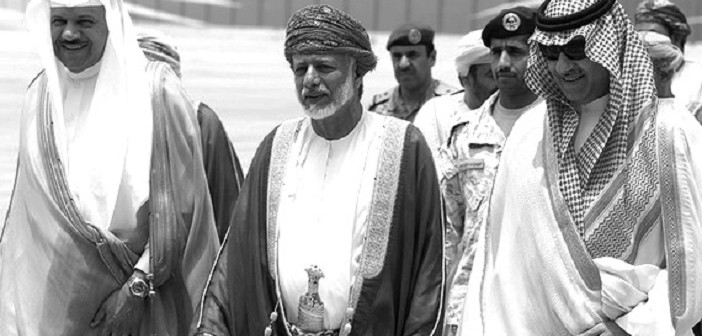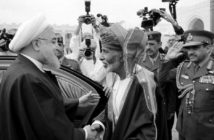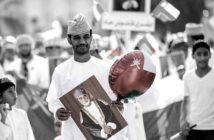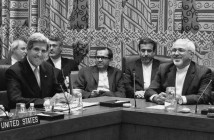Tensions continue to escalate in the Gulf region and the wider Middle East; the only actor seemingly capable of any diplomatic cooling down is Oman. As shown by the Geneva debacle, both the United Nations and the United States are increasingly toothless and incapable to influence events on the ground or bring warring parties and their external backers in Syria or Yemen to the negotiating table. Russia’s brutal and disingenuous approach to solving regional crises is equally unlikely to create any sustainable compromises. Oman is the only intermediary that is trusted by both parties to the Yemen conflict, which threatens to turn into a humanitarian disaster of “Syrian” proportions if left to escalate. Moreover, Muscat has been able to talk to all sides of the Syrian conflict with the minister responsible for foreign affairs, Yousef bin Alawi, hosting Syrian opposition groups while also traveling to Damascus to talk with Bashar al Asad face-to-face on 25 October, 2015. In a tacit acknowledgement of this reality, UN Secretary General Ban Ki Moon visited Muscat in early February 2016 to express, “sincere thanks for the government and people of Oman’s contribution in international and regional peace and security”.
Oman’s balancing act is of course not a new thing; Oman has maintained ironclad -yet active- neutrality for the last four-and-a-half decades. A large part of this ability to hold the middle ground has been resistance to external influence in its affairsbuttressed by prudent allocation of its oil resource, a successful nation-building project that has kept sub-national groups invested in the state, a leadership structure that whilehighly centralized, isconsistent and unambiguous, and a socio-cultural tradition that almost sees it as a religious duty to be a “good neighbor”.
In early 2016, however, the modestly resourced sultanatehas serious problems of its own that are making its balancing act increasingly difficult. Oman’s economy is staggering under the impact of a 46% decrease in state revenue from oilsince 2014. As if to compound matters, the nation’s75 year-old leader and talisman of the country’s “renaissance”, Sultan Qaboos, departed Oman to Germany for further medical “check-ups” on 14February2016. This is the second visit of this nature to Germany. The previous visit was on 10 July 2014 and lasted for about eight months. Omanis are understandably concerned about this latest departure and his continued well-being during a critical period.
Despite efforts at diversification Oman still depends excessively on oil revenues (about 79% in 2015). So with oil prices diminishing by more than 70% since the fourth quarter of 2014, the country is facinga major budget deficit. The government plans to plug this deficit with different financing methods, including borrowing from international financial markets. Meanwhile international-rating agencies, concernedabout Oman’s fiscal situation, have downgraded Oman’s credit rating, which increases the cost of its borrowing. On 17 February 2016, Standard and Poor’s rating agency downgraded Oman’s credit rating two steps from BBB+ to negative BBB- positive. Non-government or state-owned enterprises in Oman have also been affected with local newspapers reporting negative impacts for major pillars of the economy such as telecommunications giant Omantel, and the major utilities companies, Oman Electricity Transmission Co., Oman Power and Water Procurement Co. and significantly, Oman’s biggest private financial institution, Bank Muscat. With these difficulties the country must continue to find other sources of income in the non-oil sector. However, Oman’s need for positive economic relations and investments from its neighbours –in particular Iran and Saudi Arabia–comes at a time when opposing states have growing incentive to tip Oman into their respective camps.
Oman is being pulled in both directions both economically and politically. The major question for all the oil producing states – Oman is not a member of OPEC – is the question of whether or not to reduce production in order to stabilize the global price of oil. Saudi Arabia has proposed a freeze on production at January 2016 levels that will supposedly lead to a (very) gradual decline in global stockpiles and an eventual upswing of prices. The Islamic Republic, for obvious reasons, is utterly opposed to this concept, having only just fully reentered the market following the dropping of international sanctions. Iran’s petroleum minister reacted cynically to the Saudi plan, stating: “some countries that are producing 10 million barrels per day have called on Iran to freeze its production at 1 million barrels per day!” On the surface the response by Oman to this issue appears puzzling. Desperately seeking upward pressure on oil prices to ease its budgetary crisis, Oman has offered to cut production by 10 per cent if other producers will follow suit. But at the same time, Oman’s oil minister Muhammad al Rumhi has publically supported Iran’s right to ramp up its production to reclaim lost market share. This seemingly contradictory position can only be understood within the context of Oman’s political calculations of balancing Iran against the Saudis.
Oman is one of the first countries that noticed the opportunities present in Iran. Hence Oman is at the forefront of a string of investors from different parts of the world running to its northern neighbor to get a slice of the recently opened economy. While this may give an impression of a leaning toward the Iranian side in the regional struggle, a longer view shows that Oman has for some time been working towards opening up the Iranian economy through its diplomatic efforts and now the sultanate seeks to cash in on the economic dividend. The work is reflected in the repeated visits of high officials of the two countries. These visits started with the visit of Sultan Qaboos to Iran in 2013. In that visit, the two countries announced a major gas pipeline project which would allow Iranian and possibly central Asian natural gas to be exported globally via Oman. It is widely believed that the visit was also the root of the deal between Iran and 5+1 powers over Iranian nuclear projects that led to the recent lifting of sanctions. Immediately, Oman and Iran announced different mutual projects including; the gas pipeline, an international private hospital in Barka, and a car factory in Al Duqum area.
Regarding these projects, the Iranian ambassador to Oman said; “We don’t forget our friends, friends who stayed with us during our previous hard times … The Government of Oman has given the land for the hospital and the Iranian Government will finance the building and other needs.” (Quoted from Radio interview with Iranian Ambassador in Oman, Al-Wisal Radio station)
Significantly Yousef bin Alawi was in Iran in late February to put the final touches to the gas pipeline project. The private sector is following on closely from intergovernmental initiatives, with Bank Muscat announcing the opening of a branch in Tehran on 16 February 2016.
These economic agreements will no doubt help Oman access vital non-oil revenue but may also give an impression of tightening relations – or even growing dependence – towards Iran at the possible expense of its GCC allies. Oman’s long tradition of independence from external influence may come under threat as it becomes reliant on high levels of foreign direct investment from its neighbours; or if natural gas distribution becomes vital to Oman’s post-oil economy, Iran’s strategic control over upstream supplies could be significant. The Iranian regime has demonstrated clearly in recent history that it is disinclined to surrender economic or strategic gains. The cases of Lebanon after 2005 and Syria after 2011 show the strength of determination that Iran can wield when challenged to roll back hard-won footholds in the Arab world.
On the political level a similar “tug of war” is forcing Oman into new diplomatic contortions that challenge its determination not to lose its independence and neutrality. Saudi Arabia’s execution of the Shi’a dissident, Sheikh Nimr al Nimr in early January 2016 was followed by a furious Iranian retaliation including mob attacks against Saudi diplomatic facilities in Tehran. While Saudi Arabia looked to unify its GCC and Sunni allies in the face of spiraling tensions with Iran, Oman “maintained its cool”. The sultanate condemned the attacks on Saudi diplomatic premises, and welcomed the December 2015 formation of the 34 country Saudi-led coalition to fight “terrorism”, while at the same time politely opting out of any formal membership of it – which of course would have imperiled its good offices with Tehran. Nonetheless, according to different sources Oman is participating in the “Northern Thunder” military exercise being conducted in northern Saudi Arabia. According to the Gulf news agency; “Troops from Oman, Egypt and Kuwait and several other countries have arrived in Saudi Arabia to take part in the largest military exercise in the region, in terms of participating countries and equipment”. According to the same agency, the objective of the exercise “is to demonstrate the high combat readiness of the participating armed forces and their readiness and ability to function successfully in joint operations”. Although Oman, is most likely participating in a minor or observational capacity, in a clear message to Iran Saudi media is looking to highlight Oman’s participation.
Despite US power wavering in the region under the Obama administration, the US remains a major guarantor of Oman’s security. The closeness of the relationship is illustrated in Oman’s assistance to the US in the gradual shutdown of the Guantanamo Bay facility. Since January 2015, 21 -mostly Yemeni- detainees have been transferred from Guantanamo to Oman, with the latest transfer of 10 prisoners occurring in January 2016. Underlining its commitment to Oman, the US described Oman as an “important force for political stability and economic progress in the Middle East”, as it approved a $51 million-dollar missile sale to the Sultanate. The Obama administration further demonstrated how much it values Oman’s friendship when it reportedly intervened to delay and favourably adjust a ‘Trafficking of Persons Report’ that threatened to downgrade Oman’s status from Tier 2 to Tier 2-Watch list.
Despite recent signs that Oman is moving closer to Iran, the durability of relations between Oman and Saudi Arabia should not be understated at the political or grassroots level. Most Omani family’s will sit down to breakfast daily with iconic Saudi brands like Al-Marie milk and other products. These products and others are representative of the high direct trade between Oman and Saudi Arabia. Saudi Arabia is one of Oman’s most important trade partners, a relationship that will be strengthened upon completion of a new highway expected to be ready by the end of 2018. The cross-desert highway will link the two countries in important ways. It will facilitate Saudi and GCC tourists travelling to Salalah and other popular destinations in Oman, but also channel the regular stream of Omanis heading to Mecca, Medina and other locations. It will also ease the exchange of goods between the two countries. This new easiness of exchange will allow linkage to the major logistics projects underway in the al-Duqum Area on the Oman coast. In the future this outlet to global trade may prove an optimal door for Gulf countries needing to bypass the straits of Hormuz. Besides these economic and geostrategic factors, similar language, religion and cultures continue to underpin durable Saudi-Omani relations.
Oman’s predicament, walking a tightrope between two powerful antagonists, is similar to an analogy of an unfortunate mutual friend in a schoolyard scrap. Both antagonists escalate aggressive rhetoric as they steadily proceed towards violence. Both of them perceive the other as the guilty one and the go-between is stuck in the middle. He has three options, which are; being on one side with friend A, taking the other side with friend B or trying to remain independent. Choosing neutrality in fact risks alienation from both friends as each will start perceiving the go-between as closer to the other one. They will start creating problems for him to try to pull him to one side. This is the situation facing Oman; however, the stakes are very high and it remains to be seen whether it can maintain its stance of permanent and active neutrality especially as it faces increasingly tough economic and political times.
by Leon GOLDSMITH and Omran Al-ABRI





